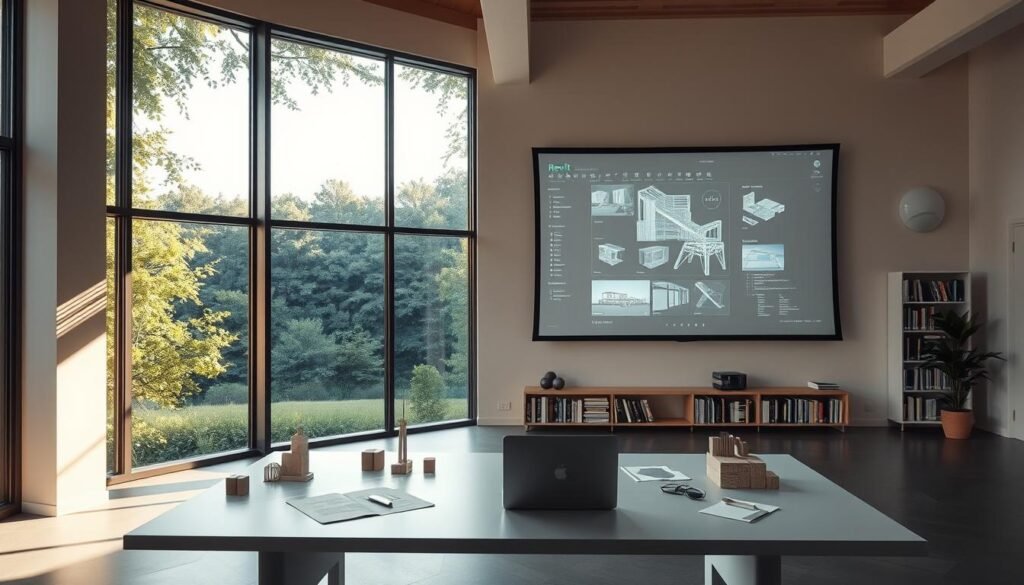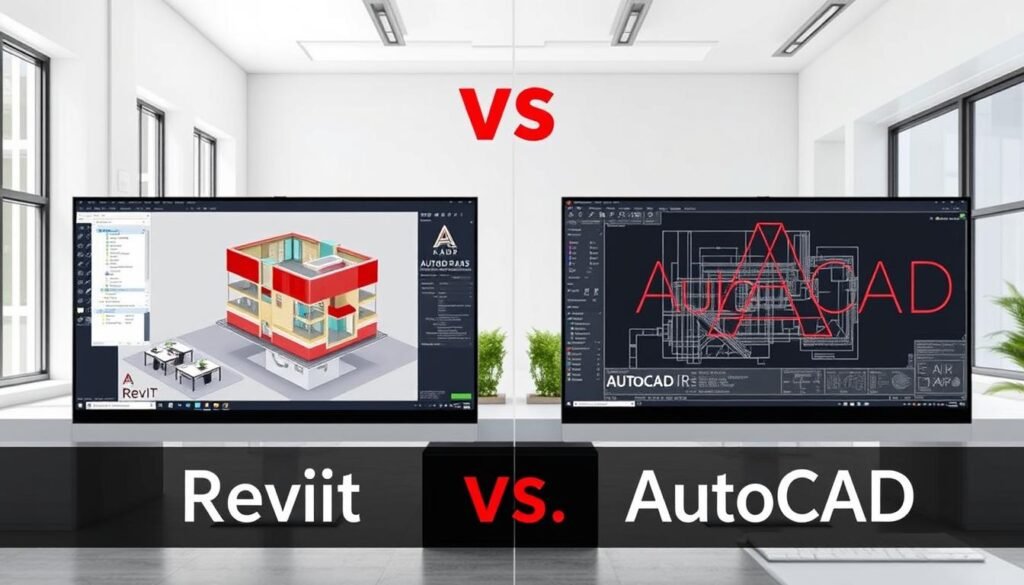Revit has become an indispensable tool in the architecture, engineering, and construction (AEC) sector, revolutionizing design capabilities, streamlining workflows, and enhancing building performance. The escalating demand for proficient AEC professionals underscores the critical need for superior Revit training.
Multiple online Revit courses are accessible, provided by entities such as Novatr, Kaarwan, TechnoStruct Academy, BIMscape, and Skill-Lync. Nonetheless, not all courses are equivalent, necessitating architects to meticulously evaluate the attributes that define an effective Revit course for their professional development.
Key Takeaways
- Revit is a pivotal tool for AEC professionals, enhancing design and building performance.
- A high-quality Revit course is essential for architects to improve their skills.
- Key features of an effective Revit course include comprehensive training and practical experience.
- Institutions such as Novatr, Kaarwan, and Skill-Lync offer online Revit courses.
- Architects must carefully consider the features that make a Revit course effective for their needs.
The Growing Importance of Revit Skills in Architecture
Revit has become indispensable in contemporary architecture, facilitating streamlined workflows and enhanced collaboration. As architectural endeavors escalate in complexity, the imperative for efficacious design and management methodologies intensifies.
How Revit Has Transformed Architectural Design Workflows
Revit has transformed architectural design workflows by facilitating real-time collaboration, parametric modeling, and optimized project management. This transformation has resulted in augmented productivity and diminished errors in project execution. Key advantages of Revit include:
- Enhanced collaboration among project stakeholders
- Automated documentation and diminished manual errors
- Parametric modeling for intricate designs
Career Benefits of Revit Proficiency for Indian Architects
Employers increasingly seek Revit proficiency, leading to superior job prospects and remunerations for architects in India. A best Revit course for architects equips professionals with the requisite skills to remain competitive in the employment arena. The subsequent table elucidates the career advantages of Revit proficiency:
| Career Benefit | Description |
|---|---|
| Improved Job Prospects | Heightened demand for Revit-skilled architects in the Indian employment market |
| Higher Salaries | Revit proficiency often precipitates elevated remuneration packages for architects |
| Enhanced Career Growth | Prospects for career progression in architectural firms and construction entities |
By acquiring Revit skills through a distinguished Revit architecture training program, Indian architects can substantially augment their career prospects and maintain a competitive edge in the dynamic architectural domain.
What Defines the Best Revit Course for Architects
The quintessence of the premier Revit courses for architects lies in their amalgamation of curricula pertinent to the industry, tutelage by experts, and an array of support resources. This synergy ensures a pedagogical experience that is both enlightening and practically applicable, equipping architects with the proficiency to adeptly employ Revit in their professional endeavors.
Industry-Relevant Curriculum and Project-Based Learning
An exemplary Revit course must boast an industry-relevant curriculum that resonates with contemporary architectural methodologies and software paradigms. It should incorporate project-based learning, where students engage with authentic projects to acquire experiential knowledge. For example, Novatr’s BIM Professional Course integrates practical assignments that simulate real-world scenarios, thereby enabling learners to directly apply their acquired skills in their professional roles.

Instructor Expertise and Teaching Methodology
The proficiency of instructors is paramount in a Revit course, as they impart wisdom and insights derived from their professional experiences. Effective pedagogical approaches, such as interactive sessions and personalized feedback, significantly augment the learning experience. Instructors with profound knowledge of Revit and its applications in architecture can impart invaluable insights, aiding learners in overcoming typical hurdles and mastering sophisticated techniques.
Technical Support and Learning Resources
Comprehensive technical support and an extensive array of learning resources are indispensable components of an outstanding Revit course. This encompasses access to the software, tutorial videos, and forums where learners can solicit assistance and disseminate their own knowledge. Courses that provide robust support resources, such as Kaarwan’s Advance Revit & BIM Certification Course, guarantee learners the requisite support to excel, both during and post-course.
By concentrating on these pivotal aspects, architects can discern the best Revit course for their requirements, one that not only imparts the technical competencies necessary for Revit mastery but also readies them for the complexities of the architectural vocation.
Online vs. In-Person Revit Architecture Training: Making the Right Choice
The decision between online and in-person Revit architecture training is pivotal for Indian professionals aiming to refine their skills. Each method boasts distinct advantages, catering to diverse learning preferences and styles.
Advantages of Online Revit Courses for Indian Professionals
Online Revit courses provide unparalleled flexibility and accessibility, empowering Indian professionals to learn at their convenience. Key benefits include:
- Self-paced learning, enabling professionals to balance work and study
- Access to a wide range of resources and materials
- Cost-effectiveness, reducing expenses related to travel and accommodation
- Opportunity to learn from instructors worldwide, gaining diverse perspectives
As Autodesk, the developer of Revit, notes, “The future of learning is online, and it’s changing the way we acquire new skills.” Online courses are particularly advantageous for those with demanding schedules or limited access to in-person training facilities.
When Traditional Classroom Training Makes More Sense
Despite the numerous benefits of online training, certain scenarios favor traditional classroom training. These include:
- Hands-on experience with direct supervision from instructors
- Immediate feedback and interaction with peers
- Access to specialized software and hardware
- Networking opportunities with fellow professionals
| Training Method | Key Benefits | Ideal for |
|---|---|---|
| Online Training | Flexibility, cost-effectiveness, self-paced learning | Busy professionals, those with limited access to in-person training |
| In-Person Training | Hands-on experience, immediate feedback, networking opportunities | Those who prefer direct interaction, need hands-on practice |
In conclusion, the choice between online and in-person Revit architecture training hinges on individual preferences, learning styles, and career objectives. By comprehending the advantages of each, Indian professionals can make informed decisions to enhance their Revit skills effectively.

Comprehensive Checklist for Evaluating Revit Courses
Assessing the quality of Revit courses tailored for architects necessitates a structured checklist. Key factors include course content, learning experience, cost, and post-course support. These elements are pivotal in evaluating the suitability of a Revit course for architects.
Course Content and Curriculum Assessment
The curriculum of a Revit course must align with industry standards and cover critical topics. Essential aspects to evaluate include:
- BIM Standards and Indian Building Code Compliance: Verify that the course adheres to the latest BIM standards and complies with Indian building codes, such as NBC 2016.
- Advanced Modeling and Documentation Features: The course should explore advanced Revit features, including complex modeling and detailed documentation processes.
Learning Experience Factors
The learning experience is a critical component of any Revit course. Key factors to consider include:
- Hands-on Projects Relevant to Indian Architecture: The course should provide practical projects that reflect real-world Indian architectural scenarios, enhancing the learning experience.
- Community and Networking Opportunities: Opportunities to interact with peers and industry professionals can significantly enhance the learning process.
Cost-to-Value Considerations
While cost is an important factor, assessing the value derived from the course is equally crucial. Considerations include:
- Payment Options and Course Flexibility: Flexible payment options and course structures can make a significant difference, especially for working professionals.
- Return on Investment for Indian Architects: Evaluate how the course can enhance career prospects and increase earning potential in the Indian architectural market.
Post-Course Support and Career Advancement
Support after completing the course is vital for long-term success. Key aspects to evaluate include:
- Certification and Portfolio Development: The course should offer certification upon completion and assist in developing a professional portfolio.
- Job Placement Assistance in the Indian Market: Assistance with job placement in the Indian architectural market can be a significant advantage.
Utilizing this comprehensive checklist enables architects to make informed decisions when selecting a Revit course. This ensures the course meets their specific needs and enhances their career prospects.
Conclusion: Investing in Your Architectural Future Through Quality Revit Training
Quality Revit training is indispensable for architects aiming to bolster their career prospects and maintain competitiveness within the field. A well-rounded Revit architecture training program profoundly influences an architect’s trajectory, equipping them with the necessary skills and knowledge to thrive professionally.
The paramount Revit course for architects must integrate an industry-relevant curriculum, project-based learning, and the guidance of seasoned professionals. Opting for such a course empowers architects to master the competencies essential for excelling in the dynamic architectural environment of today.
Given the escalating significance of Revit proficiency in architecture, it is imperative for professionals to commit to quality training that resonates with their career aspirations. This strategic investment opens up novel avenues and positions them at the forefront of the continuously evolving AEC sector.

